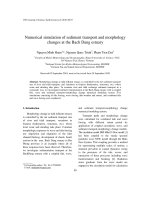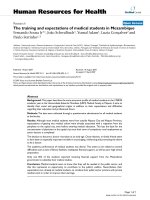the improvement of the training and development program at bitis company
Bạn đang xem bản rút gọn của tài liệu. Xem và tải ngay bản đầy đủ của tài liệu tại đây (719.45 KB, 120 trang )
THE IMPROVEMENT OF THE TRAINING AND DEVELOPMENT
PROGRAM AT BITIS COMPANY IN VIETNAM
A Research Proposal
Presented to the Faculty of Graduate School
Southern Luzon State University, The Philippines and
Thai Nguyen University, Socialist Republic of Vietnam
In Partial Fulfillment of
The Requirements for the Degree
Doctor in Business Administration
PHAM DO DUNG
(JONATHAN)
July, 2013
Thai Nguyen University
Socialist Republic of Vietnam
Southern Luzon State University
Republic of Philippines
Dissertation
1
ACKNOWLEDGMENT
In grateful recognition and sincerest thanks for the encouragement, guidance and
unselfish sharing of their knowledge, time, effort and skills, and for the untiring
motivation that leads to the completion of this study, the Researcher acknowledges
the following:
DR. CECILIA N. GASCON, Ph. D., President of the Southern Luzon State
University in the Republic of the Philippines, for her untiring effort and belief that
this collaboration is possible thus enabling us to pursue the DBA degree;
DR. NGUYEN THANH HAI, Vice Director of the International Training Center Thai
Nguyen University of the Socialist Republic of Vietnam, for his enormous pursuit to
provide the Vietnamese people an opportunity to grow through education;
DR. JOANNA PAULA A. ELLAGA for her selfless guidance and assistance thereby
making this paper a scholarly work;
MANAGERS and EMPLOYEES of Biti‟s company, my Respondents, for their
patience and cooperation in answering the questionnaire and for other data given;
MY FAMILY and FRIENDS and to all who have contributed to make this study a
success.
Dissertation
2
ABSTRACT
Dissertation mentions the necessary of training, aims and objectives of studying.
According to experts, training is crucial element, such as maintaining the absorptive
capacity of innovative firms, or a key part of the human resource management process
and even improving the quantity and quality of future entrepreneurs. Scientists also
assert that there are a number of reasons for training. In addition, the significantly
impacts of training and training benefits are also been confirmed. Finally, good results
for the company have implemented well training programs is obvious evidences to
emphasize the important of training.
A number of methods were used in this studying. Collecting primary data from books,
journals, articles, research papers and reports, and based on these data, the author do
questionnaires, sending to BITIS Company and collecting the feedbacks. Then, a
mixture of qualitative and quantitative approaches to analyzing the primary research
findings was chosen, with an emphasis on qualitative data.Questionnaires were
chosen as the main tool to carry out the research. Finally, the sampling method and
pilot study are also approached in this project.
Overview of BITIS have been mentioned covering the main background information
of company, the strength, the weakness and strategies that BITIS have done to
achieve their goals and widely recognized in global market are described and
explained. Then, analyzing the results from questionnaires feedback is analyzed.
Author has summarized the results of studying, and has confirmed that the targets of
studying has achieved. Some recommendations are suggested which hope these can
be applied in the BITIS company.
Dissertation
3
TABLE OF CONTENTS
ACKNOWLEDGMENT 1
ABSTRACT 2
CHAPTER I 7
INTRODUCTION 7
1.1 The significance of study 7
1.2 Background of the Study 12
1.3 Aims of Study 13
1.4 Objectives of Study 14
1.5 Scope and limitations of Research 15
CHAPTER II 16
REVIEW OF RELATED LITERATURE 16
2.1 The importance of training and development 16
2.2 Transfer of training 20
2.2.1 Individual factors 21
2.2.2 Motivational factors 23
2.2.3 Environmental factors 25
2.3 Training methods 27
2.3.1 Videotapes 27
2.3.2 Lectures 28
2.3.3 One-on-one instruction 29
2.3.4 Role plays 31
2.3.5 Games/simulation 31
2.3.6 Case studies 32
2.3.7 Slides 33
Dissertation
4
2.3.8 Computer-based training 34
2.3.9 Audiotapes 35
2.3.10 Films 35
2.4 The factors influence the training 35
2.4.1 Internal factors 36
2.4.2 External factors 37
2.5 The brief overview of the steps of the training process follows 38
CHAPTER III 42
RESEARCH METHODOLOGY 42
3.1 Research design 42
3.2 Research tool 44
3.3 Sampling method 46
3.4 Research technique 47
3.5 The Pilot Study 47
3.6 Procedure 48
3.7 Reliability and Validity 48
3.7.1 Reliability 49
3.7.2 Validity 49
3.8 Data analysis 50
CHAPTER IV 51
RESULTS AND DISCUSSION 51
4.1 The background of Bitis company 51
4.1.1 Historical background 51
4.1.2 Organization’s framework 52
4.1.3 Bitis strategies 52
Dissertation
5
4.1.4 Human Resources Management and Development 54
4.2 Worker-respondent 55
4.2.1 Age 55
4.2.2 Gender 56
4.2.3 Length of service 57
4.2.4 Department assigned 58
4.2.5 The worker’s perception on the company’s training and development
program in terms of policies and procedure 59
4.2.6 The worker’s perception on the company’s training and development
program in terms of awareness on training process 60
4.2.7 The worker’s perception on the company’s training and development
program in terms of attendance to a fomal training 61
4.2.8 The worker’s perception on the company’s training and development
program in terms of training method 62
4.2.9 The worker’s perception on the company’s training and development
program in terms of motivation to attend a training 64
4.2.10 The worker’s perception on the company’s training and development
program in terms of usefulness of the training 65
4.2.11 The worker’s perception on the company’s training and development
program in terms of gains acquired from the training 67
4.2.12 The worker’s perception on the company’s training and development
program in terms of applicability of training to specific job/tasks 69
4.2.13 The worker’s perception on the company’s training and development
program in terms of manager’s role in the training process 72
Dissertation
6
4.2.14 The worker’s perception on the company’s training and development
program in terms of Influencing factors in the training process 74
4.2.15 The worker’s perception on the company’s training and development
program in terms of commitment to attend trainings 76
4.2.16 The worker’s perception on the company’s training and development
program in terms of suggestions to improved the training process 79
CHAPTER V: SUMMARY, CONCLUSIONS AND RECOMMENDATIONS 81
5.1 Summary 81
5.2 Conclusions 81
5.3 Recommendations 83
5.3.1 In respect of training policy 83
5.3.2 With respect of methods training 84
5.3.3 With regard to training evaluation 85
5.3.4 In respect of commitment 86
5.3.5 With respect of working environment 86
5.4 Limitations of Research 89
5.5 Further Research 90
BIBLIOGRAPHY 91
APPENDIX 99
CURRICULUM VITAE 119
Dissertation
7
CHAPTER I
INTRODUCTION
The rapid growing and integration of global economy has extensively enhanced the
demand for training and education. Given this reason, it will be significant to
recognise the role of training in economic development, particularly for companies
which compete in competitive market. Since training plan, method and trainee
recognition is considered as the substantial predicator to measure the effectiveness
and succeed of training program. Therefore, training plan, method and trainee
recognition have been received much attention from researchers as well as board of
management in over the world;
1.1 The significance of study
People are the factors that constitute the organization, operation and determine the
success or failure of the organization. This is a valuable asset that every organization
should know to take advantage and develop. Furthermore, in integration of global
economy, the training and development of human resources is considered as a vital
task for every organization because strong human resources is the prerequisite to
compete and survive in today's competitive environment. Therefore, the improvement
of training quality takes an important part in development strategy
Training is the acquisition of knowledge, skills, and competencies as a result of the
teaching of vocational or practical skills and knowledge that relate to specific useful
competencies.
Dissertation
8
Training has specific goals of improving one's capability, capacity, and performance.
In addition to the basic training required for a trade, occupation or profession,
observers of the labor-market recognize the need to continue training beyond initial
qualifications: to maintain, upgrade and update skills throughout working life.
Training presents a prime opportunity to expand the knowledge base of all employees,
but many employers find the development opportunities expensive. Employees also
miss out on work time while attending training sessions, which may delay the
completion of projects. Despite the potential drawbacks, training and development
provides both the company as a whole and the individual employees with benefits that
make the cost and time a worthwhile investment.
Training plan, method and trainee recognition have been received much attention
from researchers as well as board of management in over the world:
Addressing Weaknesses: Most employees have some weaknesses in their workplace
skills. A training program allows you to strengthen those skills that each employee
needs to improve. A development program brings all employees to a higher level so
they all have similar skills and knowledge. This helps reduce any weak links within
the company who rely heavily on others to complete basic work tasks. Providing the
necessary training creates an overall knowledgeable staff with employees who can
take over for one another as needed, work on teams or work independently without
constant help and supervision from others.
Improved Employee Performance: An employee who receives the necessary training
is better able to perform her job. She becomes more aware of safety practices and
proper procedures for basic tasks. The training may also build the employee's
Dissertation
9
confidence because she has a stronger understanding of the industry and the
responsibilities of her job. This confidence may push her to perform even better and
think of new ideas that help her excel. Continuous training also keeps your employees
on the cutting edge of industry developments. Employees who are competent and on
top of changing industry standards help your company hold a position as a leader and
strong competitor within the industry.
Consistency: A structured training and development program ensures that employees
have a consistent experience and background knowledge. The consistency is
particularly relevant for the company's basic policies and procedures. All employees
need to be aware of the expectations and procedures within the company. This
includes safety, discrimination and administrative tasks. Putting all employees
through regular training in these areas ensures that all staff members at least have
exposure to the information.
Employee Satisfaction: Employees with access to training and development programs
have the advantage over employees in other companies who are left to seek out
training opportunities on their own. The investment in training that a company makes
shows the employees they are valued. The training creates a supportive workplace.
Employees may gain access to training they wouldn't have otherwise known about or
sought out themselves. Employees who feel appreciated and challenged through
training opportunities may feel more satisfaction toward their jobs.
The overall objective of the training and development of human resources is to take
advantage of existence human resources and improve the effectiveness of
organization. There are three reasons that training and development is needed
Dissertation
10
• To meet the needs of survival and development organizations
• To meet the learning demand of workers
• To create the business competitive advantage
The necessity of training and development has been the sustainably researched
worldwide as the followings discussion.
The intensity of competition and pace with which knowledge becomes obsolete are
heralding an era where leadership, structure and control systems must increasingly
focus on the management of knowledge and skills. Such an environment requires
management to systematically design an infrastructure that is tailored to the needs of
an increasingly mobile knowledge worker and supports organisational learning in
areas of strategic concern(Cross and Funk,2007).
Many management theorists have paid tribute to today‟s knowledge worker and the
dramatic paradigm shift that managing such an employee has brought to our
society(Naisbitt and Aburdene,2000; Toffler,2000; Crawford,2001). As well
articulated by Peter Drucker (2003), We are now in a knowledge society „knowledge
society‟ where knowledge is quickly eclipsing traditional factors of production such
as labour, capital and land. Nowhere is this more true than in high- end knowledge
work sectors such as professional services, software development, financial services
and technical product development- areas where an organisation‟s ability to tap the
intangibles of employee judgment and creativity are critical. To thrive and grow in
today‟s dynamic business environment, it is increasingly important that businesses in
such knowledge- intensive industries organise to leverage the collective intellect and
creativity of its entire employee base(Cross and Fund,2007) .
Dissertation
11
The rise of highly competitive, technology- based information society has caused a
great need for skilled workers. Studies by the Ministry of Labour, Invalids and Social
Affairs (MOLISA) show that 62 per cent of reporting companies have a short- age of
skilled workers and 73 per cent of manufactures believe entry- level workers lack the
necessary skills to positively impact their company in Vietnam (Labour,2011).
Today‟s knowledge worker must exhibit judgment, creativity, technical expertise and
interpersonal skills that promote knowledge creation- intangibles that often cannot be
forced like a labour standard on an assembly line (Nonaka and Takeuchi,2005).
Vietnam is undergoing a transition from a centrally planned to a market- oriented
economy . A shortage of skilled labour exists in Vietnam, largely due to an antiquated
educational system and the country‟s recent opening to major amounts of foreign
investment. This is a ubiquitous problem in Southeast Asia as a whole: skilled labour
is in demand, and managers who are available tend to be unfamiliar with new
technologies. This lack of technical know-how and language skills tends to hamper
new investment. Recently, this problem was illustrated in Intel Corporation‟s
assertion that they will not pursue in country manufacturing due to the lack of a
significant pool of skilled engineering labour and unreliable power supplies.
(Investment, 2010).
Therefore the acquisition of such skills is critical for today‟s workers if they expect to
obtain and keep their jobs, as well as excel in a work environment and it is a way to
attract the foreign investment while the Vietnamese government has implemented
many investment incentives.
Dissertation
12
Training is the key. Traditionally, training and development were not viewed as an
activity that could help companies create value and successfully deal with competitive
challenges. Today that view has changed. Companies that use innovative training and
development practices are likely report better financial performance than their
competitors who do not. Training and development also helps a company to meet
competitive challenges. As companies attempt to expand into foreign market places,
their success will be determined by their employees‟ ability to work in a new culture
(the global challenge) (Noe,2008).
1.2 Background of the Study
Bitis is a leading company in Vietnam in manufacturing footwear sector. Founded in
1982, until now, Bitis has grown rapidly nationwide, including 4 commercial centres,
1 business centre, 4 branches and more than 4,500 agents - shops over 63 provinces
Vietnam. In addition, the company has more than 40 exporting markets in the world:
Taiwan, South Korea, Israel,, England, Poland, Portugal, Brazil, Canada
However, in a long time, Vietnam's footwear market was overwhelming by Chinese
footwear. Although with lower quality than Bitis shoes but with various designs and
prices are so much cheap, Chinese footwear has quickly won the hearts of Vietnamese
consumers. Facing the risk of losing market share to a strong competitor _ which is
the world's largest footwear and the largest footwear manufacturer in the world, this
was a hard situation for the Bitis management
The fact that Bitis management has applied several measures to stabilize the market
for company but have not really succeeded.
Dissertation
13
Many reasons have been reviewed, one of them is that education policy and human
resources development in company.
In fact, Bitis as well as other Vietnamese companies, especially the large one have
invested in human resource development but it has not yet become strategic objectives
of the business. The recruitment, employment and training new employees is executed
only in a short time yet long-term goals. Many businesses have to face with the
continuous jumping labour, especially during economic instability. Meanwhile,
training and development of human resources are principally important since the
majority of Vietnam's labor lack of knowledge and skills by the education system and
professional training did not meet the requirements business
Bitis have faced a difficulty regarding quality of worker, the lack of high skilled
workers is another weakness point of Bitis. That is the results of low level
professional in recruiting human resources for company. Moreover, lower awareness
and less responsible made by a small part of labor forces is still adverse impacting on
company development.
Therefore, I have selected topics: “THE IMPROVEMENT OF THE TRAINING
AND DEVELOPMENT PROGRAM AT BITIS COMPANY” for my research. With
a desire to make a small contribution to improving the quality of human resources at
the company Bitis.
1.3 Aims of Study
+ To evaluate the factors influence the training process at Bitis company
Dissertation
14
+ To recommend a best practice strategy for prevention of the negative influence for
training and develop human resource in organisation.
+ To outline solutions for the process to improve the training and develop human
resource at Bitis company.
1.4 Objectives of Study
1. To know the respondent‟s profile in terms of the following
1.1 Company – respondent
1.1.1 Historical background
1.1.2 Organization‟s frame work
1.1.2 Strategies
1.1.3 Human resources and development
1.2 Worker – respondent
1.2.1 Age
1.2.2 Gender
1.2.3 Length of service
1.2.4 Department
2. To determine the worker‟s perception on how the company conducts training
and development program in terms of the following aspects
2.1 Policies and procedures
2.2 Awareness of employees on training process
2.3 Attendance to a formal training
2.4 Training method
2.5 Motivation to attend a training
2.6 Usefulness of the training
Dissertation
15
2.7 Gains acquired from the training
2.8 Applicability of training to specific job/tasks
2.9 Manager‟s role in the training process
2.10 Influencing factors in the training process
2.11 Commitment to attend trainings
2.12 Suggestions to improved the training process
3. To design an improved training and development program for the company
1.5 Scope and limitations of Research
The study concentrated on one organisation only, Bitis company. This was due to the
fact that the author was unable to gain access to employees at any other organisation.
The study was also limited to research in one geography area, Hanoi. This introduced
regional bias and consequently the sample is unrepresentative and generalisations to
the wider population should be taken with caution. Therefore, only further research in
other organisations across a greater geographical spread could prove or disprove the
research findings. It was hoped that the sample size would have been larger than that
which was achieved.
Dissertation
16
CHAPTER II
REVIEW OF RELATED LITERATURE
This chapter aims to briefly criticise previous literature review about training and
development. First, the concepts and importance of training and development is
looked at. Second, the transfer and method training is discussed. Third, the factors
influences the training are mentioned. Finally, this chapter presents the summary of
the steps of training process.
2.1 The importance of training and development
Training and Development helps in optimizing the utilization of human resource that
further helps the employee to achieve the organizational goals as well as their
individual goals. Training and Development helps in increasing the job knowledge
and skills of employees at each level. It helps to expand the horizons of human
intellect and an overall personality of the employees.
Training and Development helps in increasing the productivity of the employees that
helps the organization further to achieve its long-term goal. Training and
Development helps in inculcating the sense of team work, team spirit, and inter-team
collaborations. It helps in inculcating the zeal to learn within the employees.
Training and Development helps to develop and improve the organizational health
culture and effectiveness. It helps in creating the learning culture within the
organization. Training and Development helps building the positive perception and
feeling about the organization. The employees get these feelings from leaders,
Dissertation
17
subordinates, and peers. Training and Development helps in improving upon the
quality of work and work-life.
Training and Developmenthelps in creating the healthy working environment. It helps
to build good employee, relationship so that individual goals aligns with
organizational goal. Training and Development helps in improving the health and
safety of the organization thus preventing obsolescence.
Training and Development helps in improving the morale of the work force. Training
and Development helps in creating a better corporate image. Training and
Development leads to improved profitability and more positive attitudes towards
profit orientation.
Training and Development aids in organizational development i.e. Organization gets
more effective decision making and problem solving. It helps in understanding and
carrying out organisational policies. Training and Development helps in developing
leadership skills, motivation, loyalty, better attitudes, and other aspects that successful
workers and managers usually display.
Training in the workplace has been highlighted as an essential element in maintaining
the absorptive capacity of innovative firms (Prince, 2002). Indeed, training is now
seen as a key part of the human resource management process (Gunnigle et al., 2005),
where workers are viewed as a source of wealth creation, rather than a cost to the
company (Walley, 2003).
Organisations provide training for many reasons. They orient new hires to
organisation or teach them how to perform in their initial assignment. They improve
the current performance of employees who may not be working as effectively as
Dissertation
18
desired or prepare employees for future promotions or for upcoming changes in
design, processes or technology in their present jobs (Fisher et al., 2009). Training can
help an organisation succeed in a numbers of ways. Traditionally, training facilitates
the implementation of strategy by providing employees with the skills and knowledge
needed to perform their jobs. Training also assists in solving immediate business
problems, such as when a team of managers in an action learning programme studies
a real problem and recommends a solution. Finally, to keep ahead in a highly
competitive and turbulent environment, it has been suggested that the training
function must foster a continuous learning culture and stimulate managers to reinvent
their corporation (Martocchio and Baldwin, 2007).
Therefore from company‟s perspective training and development of company
employees is essential for organisational operation, and organisational advancement.
From an employee perspective, these factors are both crucial and critical for skill
development and for career advancement.
Moreover, training employees leads to increased employee satisfaction, facilitates the
updating of skills, leads to an increased sense of belonging and benefit, increased
employee commitment to the organisation (Bushardt et al., 2004), and strengthens the
organisation's competitiveness (Hughey and Mussnug, 2007; Burden and Proctor,
2000). Job-related training increases an employee's ability to perform job-related
tasks. Job satisfaction is an important motivator for employee performance and is
negatively related to turnover (Mak and Sockel, 2009).
In addition, retention of employees, and the retention of valued skill sets, are
important for continued business achievements (Mak and Sockel, 2009). The
successful retention of employees leads to knowledge preservation within the
Dissertation
19
organisation (Cappelli, 2010). Employee turnover may lead to a loss of human
resources weakening competitive positions. At a company level, mechanisms that
allow for and promote knowledge transfer amongst employees can help minimize the
effect of the loss of skilled staff to other companies (Cappelli, 2010).
In short, employers and employees both gain from increased investment in training.
Recent research has indicated that there is a significant impact of training on
productivity in the private sector (covering 1993-2006) and that the effects of training
on productivity are larger than the effects of training on wages. An increase of one
percentage point in the proportion of employees trained is associated with about a
0.6% in productivity and a 0.3 % increase in wages (Dearden et al,2005).
Recent changes in the business environment have made the Human Resource
Development function even more important in helping organisations maintain
competitiveness and prepare for the future(Goldstein and Gilliam, 2000).
The pressure of competition and customers are demanding high- quality products and
services in addition, technological innovations require training, with employees often
needing more sophisticated skills in trouble shooting and problem solving than they
did previously. For instance, increasing number of organisations have been providing
quality management and customer service and employees must understand how to
monitor and improve the quality of goods and services in an attempt to keep up with
rising consumer expectations(Belize and Piontkowski,2000; Lee, 2001). Training is
seen as pivotal in implementing organisation- wide culture change efforts, such as
developing a commitment to customer service, adopting total quality management or
making a transition to self-directed work teams(Berry,2000; Wellins and
George,2001).
Dissertation
20
Several authors have developed methods of quantifying the benefits of training
programmes(Swanson and Gradous,2008). For instance, one study estimated that the
net return to a bank(over a five- year period) of a four-day training programme for 65
supervisors would be $ 148,400(Mathieu and Leonard,2007), Cascio (2008) provides
another example of the impact of training on productivity and performance at Cigna
Corporation, an insurance company. A seven -day training programme in basic
management skills yielded extra investment income of $ 150,000 per year. Based on a
recent survey of more than 4000 companies and in- depth case studies of training in
seven firms. Watson Wyatt, the HR consulting firm, concluded that companies that
link employee skill development to business strategy have 40 per cent higher total
shareholder return (TSR) than companies that do not (Baron and Kreps, 2009).
Since technological change influences the rate at which human capital obsolesces and
in creases the uncertainty associate with human capital investments, training may
increase or decrease at higher rates of technological change. At higher rates of
technological change, the training gap between the more and less educated narrows,
low- skilled non- production workers receive significantly more training than higher-
skilled non-production workers and the proportion of individuals receiving training
increases(Bartel and Sicherman,2008)
Training has been regarded as an expensive investment. However, we are more
concerned about how to ensure the transfer of learned skills to the work situation.
2.2 Transfer of training
Dissertation
21
Transfer of training can be defined as the application of knowledge, skills and
attitudes learned from training on the job and subsequent maintenance of them over a
certain period of time (Baldwin and Ford, 2008; Xiao, 2006). This definition broadens
the traditional meaning of transfer that only concerns the effective learning in a
training programme.
To explicate training effectiveness, it is crucial to identify and measure how
individual characteristics, job attitudes and work environment affect the transfer of
training process (e.g. Baldwin et al., 2001; Clark et al., 2003; Facteau et al., 2005;
Ford et al., 2002; 2008; Gist et al., 2001; Martocchio, 2002; Mathieu et al., 2002;
Saks, 2005; Tannenbaum et al., 2001; Tesluk et al., 2005; Tracey et al., 2005; Tziner
et al., 2001).
2.2.1 Individual factors
Trainee characteristics (e.g. personality, trainee ability, motivation effects) were
originally identified by training practitioners as factors affecting transfer of training
(Baldwin and Ford, 2008). Notwithstanding, further empirical testing of these
characteristics was very rare in earlier transfer studies. During the 1990s, the study of
these characteristics had been increasing. This section will describe the effects of such
major characteristics as personality and self-efficacy on training transfer while
motivational factors will be identified in the next section under its own heading.
Among various personality variables, locus of control was hypothesised in many
earlier studies to affect the transfer process (e.g. Baumgartel et al., 2004; Noe and
Schmitt, 2006). Locus of control is defined by Rotter (1996) as a generalised
expectancy that organisational outcomes in terms of rewards and reinforcements in
Dissertation
22
life are controlled either by an individual's own actions (internality) or by other forces
(externality). In a training situation, trainees with a strong belief that they can control
the provision of organisational outcomes are more likely to facilitate the application
of training content on their jobs. Such outcomes can be recognition, promotions,
salary increases and job enlargement. The recent study of Tziner et al. (2011)
indicated that those with an internal locus of control who benefited from a relapse
prevention module exhibited higher levels of mastering the training contents. They
were more likely to use trained skills and transfer strategies and were shown to
transfer those trained skills to the workplace.
The effects of self-efficacy on transfer have been widely studied recently. Self-
efficacy is defined as "people's judgements of their capabilities to organise and
execute courses of action required to attain designated types of performances"
(Bandura, 2006, p. 391). It is clear that trainees with a high level of confidence in
attaining anticipated performance and behaviour change will be more likely to apply
what they have learned from training on the jobs. Empirically, self-efficacy was
shown to be positively related to pretraining motivation (Quinones, 1995), training
performance in various training programmes (Gist, 2009; Gist et al., 2001;
Tannenbaum et al., 2001) and posttraining behaviour (Latham and Frayne, 1999; Gist,
1999; Mathieu et al., 2002; Saks, 2005; Tannenbaum et al., 2001), transfer
performance (Ford et al., 2008) and skill maintenance (Stevens and Gist, 2007).
Seyler et al. (2008) further found that trainees with a high level of confidence to
training were more motivated to transfer the newly acquired knowledge and skills.
Dissertation
23
2.2.2 Motivational factors
Many motivational factors proposed to affect transfer of training were tested. This is
because trainees with inadequate motivation are likely to be poor in mastering the
training content and subsequent training performance. The following paragraphs will
list the testing of such motivational variables that are grouped into four major
dimensions: career and job attitudes; organisational commitment; decision and
reaction to training; and posttraining interventions.
Career and job attitudes generally refer to the cognitive state of psychological
identification with one's career and job. Actually, career and job attitudes have been
tested separately in various conceptualisations and operationalisations. However,
trainees who frequently engage in cognitive or environmental search activities are
expected to have a better understanding of their strengths, weaknesses and interests
(Noe, 2006; Noe and Schmitt, 2006). In fact, they recognise the importance of
learning new skills and refining current skills (Facteau et al., 2005) so that such skills
can match with the requirements of the new job settings. Empirically, career and job
attitudes were shown to affect pretraining motivation. Trainees who had both good
career planning and a high level of job involvement were more likely to be motivated
to learn (Mathieu et al., 2002; Williams et al., 2001).
Organisational commitment is originally defined by Porter et al. (1994, p.604) as "the
relative strength of an individual's identification with and involvement in a particular
organisation". It represents the extent of an individual's belief in and acceptance of
organisational goals and value, willingness to exert considerable work effort and
desire to maintain organisational membership (Mowday et al., 2002). Tannenbaum et
al. (2001) recognised that, in a training situation, the level of employees'
Dissertation
24
organisational commitment affects their views on the usefulness of training, both to
themselves and to the organisation, and the expected outcome of early training
experiences. Two recent studies showed that commitment influenced pretraining
motivation (Tannenbaum et al., 2001) and the application of training on performing
core job activities (Tesluk et al., 2005). In fact, trainees with a high level of
organisational commitment were more optimistic to perceive the likelihood of
positive organisational change.
Additionally, employees being offered opportunities to provide input into the training
decision were more likely to perceive the training as useful for their jobs which, in
turn, resulted in higher levels of pretraining motivation (Baldwin et al., 2001; Clark et
al., 2003; Mathieu et al., 2002). The pretraining motivation was said to be related to
actual learning in a training programme (Baldwin etal., 2001; Mathieu et al., 2002)
and subsequent training performance (Mathieu et al., 2002). Moreover, trainees'
reaction to training was shown to affect their learning and subsequent training
performance (Mathieu et al., 2002; Martocchio, 2002). Specifically, trainees who
perceived training as having high job and career utility were more likely to be
motivated to learn (Clark et al., 2003) and those who perceived training to be relevant
had higher level of immediate skill transfer (Axtell et al., 2007).
Finally, some post training interventions (i.e. feedback and relapse prevention) might
influence trainees' motivation to transfer new acquired skills and knowledge back to
their jobs. The study of Martocchio and Webster (2002) indicated that trainees
receiving negative feedback resulted in less learning over time than those receiving
positive feedback. Martocchio (2002), in his own study on a training intervention,
supported that positive feedback could reduce posttraining computer anxiety which, in









